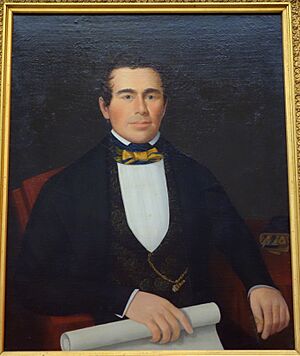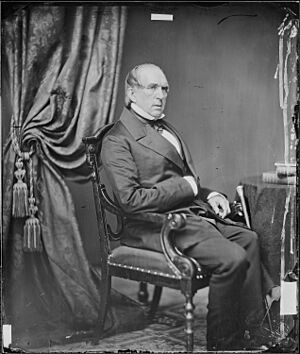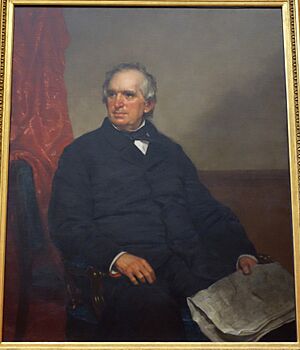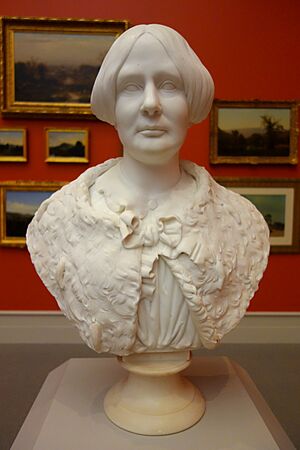Erastus Corning facts for kids
Quick facts for kids
Erastus Corning
|
|
|---|---|

Portrait of Erastus Corning by Mathew Brady, c. 1860
|
|
| Member of the U.S. House of Representatives from New York's 14th district |
|
| In office March 4, 1861 – October 5, 1863 |
|
| Preceded by | John H. Reynolds |
| Succeeded by | John V. L. Pruyn |
| In office March 4, 1857 – March 3, 1859 |
|
| Preceded by | Samuel Dickson |
| Succeeded by | John H. Reynolds |
| Member of the New York Senate from the 3rd district |
|
| In office 1842–1845 |
|
| Preceded by | Friend Humphrey |
| Succeeded by | William H. Van Schoonhoven |
| Mayor of Albany, New York | |
| In office 1834–1837 |
|
| Preceded by | Francis Bloodgood |
| Succeeded by | Teunis Van Vechten |
| Personal details | |
| Born | December 14, 1794 Norwich, Connecticut, US |
| Died | April 9, 1872 (aged 77) Albany, New York, US |
| Resting place | Albany Rural Cemetery Menands, New York |
| Political party | Democratic |
| Spouse |
Harriet Weld
(m. 1819) |
| Relations | Edwin Corning (grandson) Parker Corning (grandson) Erastus Corning 2nd (great-grandson) Edwin Corning Jr. (great-grandson) |
| Children | 5 |
| Profession |
|
Erastus Corning (December 14, 1794 – April 9, 1872) was an important American businessman and politician from Albany, New York. He was a member of the Democratic Party. Corning is best known for being the mayor of Albany from 1834 to 1837. He also served in the New York State Senate from 1842 to 1845. Later, he was a member of the United States House of Representatives from 1857 to 1859, and again from 1861 to 1863.
Corning was born in Norwich, Connecticut. When he was 13, he moved to Troy, New York, to learn how to be a merchant. He worked for his uncle's hardware store for six years. Then, he moved to Albany, New York, and worked for James Spencer's retail business. Corning eventually became the main partner in this company. He combined it with businesses he inherited to create Erastus Corning & Co. This company sold iron products like tools, farm equipment, and parts for railroads. Corning also helped create the New York Central Railroad in the 1850s and was its first president.
Corning was active in politics. Even though he was a Democrat and President Abraham Lincoln was a Republican, Corning supported the Union during the American Civil War. After leaving Congress, Corning slowly reduced his business and political work. He focused on buying and developing land in western states. He passed away in Albany in 1872 and was buried at Albany Rural Cemetery.
Contents
Early Life and Business Beginnings
Erastus Corning was born in Norwich, Connecticut. When he was two years old, he had an accident that injured his hip. This meant he had to use crutches to walk for most of his life. As an adult, he learned to use a cane, which helped him move around more easily.
Corning went to schools in Norwich and Chatham, New York. At age 13, he moved to Troy, New York, to work in his uncle's hardware store. Six years later, he moved to Albany, New York. There, he joined James Spencer's business. After some time, Corning became a partner. When Spencer died in 1824, Corning became the main partner. He combined this business with what he inherited from his uncle to form Erastus Corning & Co.
Corning's niece, Harriet, married John V. L. Pruyn. Because of this family connection, Corning and Pruyn often worked together on business deals. They invested in many areas, including insurance, banking, and buying and selling land.
Erastus Corning & Company
Erastus Corning & Co. bought and sold many types of iron products. These included tools, nails, stoves, and farm equipment. Later, they also sold railroad tracks and parts for train cars. The company had a dock and a large storage building on the Hudson River in Albany. Their store served not only Albany but also many customers from the west. These customers would visit Albany a few times a year to buy supplies.
Corning also put his money into banks and insurance companies. He bought a factory in Albany that made iron products. He renamed it the Albany Nail Factory. This factory helped him control the market for many iron goods he sold. The Albany Nail Factory later became the Rensselaer Iron Works. Under Corning's guidance, this factory was the first in the United States to use the Bessemer converter. This new technology helped make steel faster and cheaper.
By the time he was 40, Corning had helped start the Albany City Bank. He was its president until he died. He also joined the board of regents for the University of the State of New York. He began buying land in western New York. This included the areas that are now the town of Corning and city of Corning. As a Democrat, Corning also served as an Albany city council member starting in 1828. He then became mayor of Albany from 1834 to 1837.
Building Railroads
As someone who sold iron, Corning saw how important railroads would become. They would need a lot of iron for tracks and trains. When the Utica and Schenectady Railroad was created in 1833, Corning was a major investor. He also served as its president and on its board of directors. He was also a shareholder and president of the smaller Mohawk and Hudson Railroad. In 1851, these two railroads were combined to form the Mohawk Valley Railroad, and Corning was its president.
Corning stayed active in politics. He was a member of the New York State Senate from 1842 to 1845. His time in state politics made him realize that the many small railroads in New York were not very efficient. He believed they could make more money if they joined together. To make them more profitable, Corning started planning the New York Central Railroad. This company eventually became one of the largest in America. Corning was also a delegate to the Democratic National Convention in 1848 and again in 1852.
In 1853, Corning convinced the owners of six working railroads and two planned ones to combine their companies. Corning was the main person who worked to get the New York State Legislature to approve this plan. Even though he was a Democrat, he asked for help from Thurlow Weed. Weed was the leader of New York's Whig Party, which controlled the state government. Thanks to Corning and Weed, the legislature passed the Consolidation Act on April 2, 1853. As the biggest shareholder in the new company, Corning became its first president. He stayed in this job for twelve years. During this time, the New York Central grew and connected to other railways. It reached cities from New York City to Chicago, becoming one of the country's most important railroads.
Corning became very wealthy. He used his money to invest in land as far west as Wisconsin and Iowa. He bought large shares in the Chicago, Burlington and Quincy Railroad and the Michigan Central Railroad. He was also the biggest shareholder and president of the St. Mary's Falls Ship Canal Company. This company built the canal and locks on the St. Mary's River in Sault Ste. Marie, Michigan. These locks connected Lake Superior with Lake Huron. The canal company received a lot of land in the west, and Corning personally received a large portion of it.
The Civil War Years
In 1856, Corning was elected to the U.S. Congress. He served one term, from March 4, 1857, to March 3, 1859. He tried to be re-elected in 1858 but did not win. However, he was elected for a second term in 1860. He served in the 37th Congress from March 4, 1861, until he resigned on October 5, 1863.
Corning was a delegate to the 1860 Democratic National Convention. In 1861, he also attended the Peace Congress in Washington, D.C.. This meeting tried to prevent the American Civil War. Even though Corning was a Democrat, he supported the Union once the war began. However, he also criticized some of President Abraham Lincoln's actions, which he thought went too far. He resigned from Congress before his second term ended because his health was failing and he disagreed with Lincoln's way of handling the war.
In the spring of 1863, Corning organized a public meeting about Lincoln's actions. The meeting supported the Union but criticized some of Lincoln's policies. One criticism was about military arrests instead of civilian court trials for people accused of deserting the army. Lincoln wrote a long letter back, explaining why he believed the Constitution allowed a president to do these things during wartime. He famously asked, "Must I shoot a simple-minded deserter, while I must not touch a hair of a wily agitator who induces him to desert?"
Despite his disagreements with Lincoln, Corning fully supported the effort to keep the Union together. When the United States Navy decided to build ironclad ships in 1862, John Ericsson hired Corning's business partners, John F. Winslow and John Augustus Griswold. They made parts and materials for the USS Monitor, a famous ironclad ship.
Later Life and Family
From the mid-1860s, Corning started to reduce his business activities. However, he remained president of the Albany City Bank and continued as vice chancellor of the University of the State of New York Board of Regents. He passed away at his home in Albany on April 8, 1872. Corning was buried at Albany Rural Cemetery.
In 1819, Corning married Harriet Weld (1794-1883). They had five children:
- Benjamin (1820-1821)
- John (1823-1833)
- Erastus Jr. (1827-1897)
- Joseph (1829-1830)
- Edwin (1836-1871)
After Corning's death, his son Erastus Corning Jr. (1827-1897) took over the family businesses. He did not manage them well. However, after his death, his sons Edwin and Parker successfully brought the family's wealth back. Both were active in politics as Democrats. They helped create a political group that controlled Albany and Albany County for many decades. Edwin Corning served as lieutenant governor of New York from 1927 to 1928. Parker Corning served in the United States House of Representatives from 1923 to 1937.
Corning's great-grandsons, Erastus 2nd and Edwin Jr., were also important in Albany's business and politics. Edwin Jr. served in the New York State Assembly from 1955 to 1959. Erastus 2nd was the mayor of Albany for over 40 years, from 1941 to 1983.
Legacy
The papers of Erastus Corning I are kept in the collections of the Albany Institute of History & Art.
See also
- List of mayors of Albany, New York
- History of Albany, New York
- List of railroad executives






